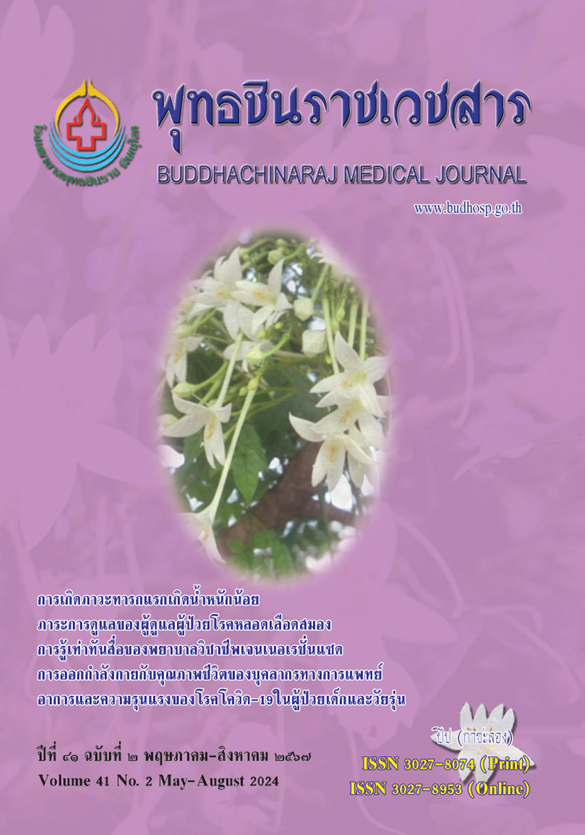ปัจจัยเสี่ยงของการติดเชื้อวัณโรคระยะแฝงในบุคลากรทางการแพทย์ โรงพยาบาลตติยภูมิ
การติดเชื้อวัณโรคระยะแฝงในบุคลากรทางการแพทย์
คำสำคัญ:
การติดเชื้อวัณโรคระยะแฝง, บุคลากรทางการแพทย์, การตรวจด้วยวิธี Interferon-gamma release assaysบทคัดย่อ
วัณโรคเป็นปัญหาสาธารณสุขที่สำคัญของประเทศไทยและทั่วโลก การตรวจคัดกรองบุคลากรทางการแพทย์ซึ่งเป็นกลุ่มเสี่ยงสูงเพื่อวินิจฉัยและรักษาการติดเชื้อวัณโรคระยะแฝง (Latent Tuberculosis Infection: LTBI) เป็นหนึ่งในมาตรการยุติวัณโรคขององค์การอนามัยโลก การตรวจวินิจฉัยด้วย Interferon-gamma release assays (IGRAs) มีข้อจำกัดในเรื่องค่าใช้จ่ายและห้องตรวจปฏิบัติการ การทราบถึงปัจจัยเสี่ยงของการติดเชื้อวัณโรคระยะแฝงช่วยให้การค้นหาและคัดกรองบุคลากรก่อนส่งตรวจวินิจฉัยมีประสิทธิภาพมากขึ้น การศึกษาย้อนหลังครั้งนี้มีวัตถุประสงค์เพื่อศึกษาปัจจัยเสี่ยงของการติดเชื้อวัณโรคระยะแฝงในบุคลากรที่มีประวัติสัมผัสใกล้ชิดผู้ป่วยวัณโรคเสมหะบวกโรงพยาบาลตติยภูมิในจังหวัดพิษณุโลกระหว่างเดือนกรกฎาคม พ.ศ. 2564 ถึงเดือนกุมภาพันธ์ พ.ศ. 2565 จำนวน 512 ราย พบบุคลากรมีผลตรวจ IGRAs เป็นบวก 94 ราย (18.4%) และผลตรวจ IGRAs เป็นลบ 418 ราย (81.6%) ปัจจัยเสี่ยงของการติดเชื้อวัณโรคระยะแฝงที่สำคัญ ได้แก่ เพศหญิง (mOR 5.8; 95%CI: 1.4-24.2) อายุ 31-40 ปี (mOR 4.5; 95%CI: 1.7-12.1) อายุ 41-50 ปี (mOR 7.4; 95%CI: 2.2-24.5) อายุมากกว่า 50 ปี (mOR 6.0; 95%CI: 1.4-26.4) ปฏิบัติงานแผนกหอผู้ป่วยใน (mOR 4.0; 95%CI: 1.8-8.6) สรุปได้ว่าการคัดกรองบุคลากรทางการแพทย์ที่เป็นกลุ่มเสี่ยงสูงของการติดเชื้อวัณโรคระยะแฝงหากมีข้อจำกัดในเรื่องงบประมาณ บุคลากรเพศหญิง อายุมากกว่า 30 ปี และปฏิบัติงานแผนกผู้ป่วยในเป็นกลุ่มเสี่ยงสูงที่ควรได้รับการพิจารณาให้ส่งตรวจ IGRAs เป็นอันดับต้นๆ
เอกสารอ้างอิง
World Health Organization. Global Tuberculosis Report 2022. World Health Organization [Internet]. 2022 Oct 27 [cited 2023 Feb 19]. Available from: https://iris.who.int/handle/10665/363752
Division of Tuberculosis. National Tuberculosis Control Programme Guideline, Thailand 2021.
nd ed. Bangkok, Thailand: Division of Tuberculosis, Ministry of Public Health; 2021. p.127.
Cohen A, Mathiasen VD, Schön T, Wejse C. The global prevalence of latent tuberculosis: A systematic review and meta-analysis. Eur Respir J 2019;54(3):1900655. doi: 10.1183/13993003.00655-2019
Uden L, Barber E, Ford N, Cooke GS. Risk of tuberculosis infection and disease for health care workers: An updated meta-analysis. Open Forum Infect Dis 2017;4(3):1-7
Kladphuang B, Yungthaisong C, Kamolwat P. Prevalence of latent TB infection among healthcare workers identified by Interferon-Gamma Release Assay (IGRA) testing in large hospital. Thai AIDS J 2021;33(1):21-35.
Rafiza S, Rampal KG, Tahir A. Prevalence and risk factors of latent tuberculosis infection among health care workers in Malaysia. BMC Infect Dis 2011;11:19. doi: 10.1186/1471-2334-11-19
Meregildo-Rodriguez ED, Yuptón-Chávez V, Asmat-Rubio MG, Vásquez-Tirado GA. Latent tuberculosis infection (LTBI) in health-care workers: A cross-sectional study at a northern Peruvian hospital. Front Med 2023;10:1295299. doi: 10.3389/fmed.2023.1295299
Sabri A, Quistrebert J, Naji Amrani H, Abid A, Zegmout A, Abderrhamani Ghorfi I, et al. Prevalence and risk factors for latent tuberculosis infection among healthcare workers in Morocco. PLoS One 2019;14(8):e0221081. doi: 10.1371/journal.pone.0221081.
Nhmoyebonde S, Leslie A. Biological differences between the sexes and susceptibility to tuberculosis. J Infect Dis 2014;209(Suppl 3):S100-6.
Dabitao D, Bishai WR. Sex and gender differences in tuberculosis pathogenesis and treatment outcomes. Curr Top Microbiol Immunol 2023;441:139-183. doi: 10.1007/978-3-031-35139-6_6
Yungthaisong C, Kamolwat P, Smitthikarn S, Lilagud O. Latent tuberculosis infection rate and TB incidence among healthcare workers in tertiary hospitals. Inst Urban Dis Control Prev J 2022;6(2):203-17.
Suwunnapang S, Prommueang R, Wattanavises S, Bunbal A, Dhepakson P, Luppanakul P, et al. Associated factors of latent tuberculosis infection among health personnel in Khon Kaen Hospital. JODPC8 2024;2(2):78-87.
Somsorn S. The prevalence and factor associated of latent tuberculosis infection among healthcare personnel in Health Region 4, 2021. Office Dis Prev Control 9th Nakhon Ratchasima J 2021;29(2):16–24.
Sangngean T. Prevalence and risk factors of latent tuberculosis infection among health care workers in Roi Et Hospital. SRIMEDJ 2022;37(4):407-18.
Yoon CG, Oh SY, Lee JB, Kim MH, Seo Y, Yang J, et al. Occupational risk of latent tuberculosis infection in health workers of 14 Military Hospitals. J Korean Med Sci 2017;32(8):1251-7.
Erawati M, Andriany M. The prevalence and demographic risk factors for latent tuberculosis infection (LTBI) among healthcare workers in Semarang, Indonesia. J Multidiscip Health Care 2020;13:197-206. doi: 10.2147/JMDH.S241972
Nonghanphithak D, Reechaipichitkul W, Chaiyasung T, Faksri K. Risk factors for latent tuberculosis infection among health-care workers in Northeastern Thailand. Southeast Asian J Trop Med Public Health 2016;47(6):1198–208.
Yeon JH, Seong H, Hur H, Park Y, Kim YA, Park YS, et al. Prevalence and risk factors of latent tuberculosis among Korean healthcare workers using whole-blood interferon-γ release assay. Sci Rep 2018;8(1):10113. doi: 10.1038/s41598-018-28430-w
Lee S, Lee W, Kang SK. Tuberculosis infection status and risk factors among health workers: An updated systematic review. Ann Occup Environ Med 2021;33:e17. doi: 10.35371/aoem.2021.33.e17
Anuradha R, Munisankar S, Bhootra Y, Dolla C, Kumaran P, Babu S. High body mass index is associated with heightened systemic and mycobacterial antigen-Specific pro-inflammatory cytokines in latent tuberculosis. Tuberculosis 2016;101:56-61. doi:10.1016/j.tube.2016.08.004
Badawi A, Liu CJ. Obesity and prevalence of latent tuberculosis: A population-based survey. Infect Dis 2021;14:1178633721994607. doi:10.1177/1178633721994607
Hen B, Gu H, Wang X, Wang F, Peng Y, Ge E, et al. Prevalence and determinants of latent tuberculosis infection among frontline tuberculosis healthcare workers in southeastern China: A multilevel analysis by individuals and health facilities. Int J Infect Dis 2019;79:26-33. doi: 10.1016/j.ijid.2018.11.010
Saag LA, LaValley MP, Hochberg NS, Cegielski JP, Pleskunas JA, Linas BP, et al. Low body mass index and latent tuberculous infection: A systematic review and meta-analysis. Int J Tuberc Lung Dis 2018;22(4):358-65. doi: 10.5588/ijtld.17.0558
Davies PDO, Yew WW, Ganguly D, Davidow AL, Reichman LB, Dheda K, et al. Smoking and tuberculosis: The epidemiological association and immunopathogenesis. Trans R Soc Trop Med Hyg 2006;100(4):291-8. doi: 10.1016/j.trstmh.2005.06.034
Prado TND, Riley LW, Sanchez M, Fregona G, Nóbrega RLP, Possuelo LG, et al. Prevalence and risk factors for latent tuberculosis infection among primary health care workers in Brazil. Cad Saude Publica 2017;33(12):e00154916. doi: 10.1590/0102-311X00154916
Szturmowicz M, Broniarek-Samson B, Demkow U. Prevalence and risk factors for latent tuberculosis in Polish healthcare workers: The comparison of tuberculin skin test and interferon-gamma release assay (IGRA) performance. J Occup Med Toxicol 2021;16(1):38. doi:10.1186/s12995-021-00326-y
World Health Organization. The Asia-Pacific perspective: redefining obesity and its treatment. World Health Organization [Internet]. Feb 2000 [cited 2024 Jul 26]. Available from: https://iris.who.int/bitstream/handle/10665/206936/0957708211_eng.pdf
ดาวน์โหลด
เผยแพร่แล้ว
ฉบับ
ประเภทบทความ
สัญญาอนุญาต
ลิขสิทธิ์ (c) 2024 ``โรงพยาบาลพุทธชินราช พิษณุโลก

อนุญาตภายใต้เงื่อนไข Creative Commons Attribution-NonCommercial-NoDerivatives 4.0 International License.






